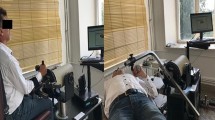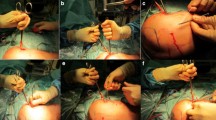Abstract
Introduction
Currently there exists no clear evidence concerning the surgical treatment of LHB lesions with either tenotomy or tenodesis. The aim of the study is therefore to evaluate elbow flexion and forearm supination force as well as the biceps muscle distalization according to both techniques in isolated LHB lesions.
Methods
Consecutive patients aged 40–70 years with shoulder arthroscopies for isolated SLAP or biceps pulley lesions were prospectively randomized to arthroscopic suprapectoral intraosseous LHB tenodesis or tenotomy. Pre-, 6 and 12 months postoperatively, the SST, ASES, Constant–Murley and LHB scores were recorded. The elbow flexion force was measured in 10°/90° flexion, the supination force in neutral/pronation position. In addition, the maximum upper-arm circumference and its position relative to the radial epicondyle of the humerus were evaluated preoperatively and in follow-up.
Results
20/22 patients (mean age 52.0 ± 8.5; range 36–63 years, 11 male) completed the follow-up. 9/20 were treated with LHB tenodesis (mean age 51.5 ± 9.5; range 37–63 years, 7 male) and 11/20 with tenotomy (mean age 52.8 ± 8.0; range 36–62 years, 4 male). The force measurements and scores showed no significant difference after 12 months. Tenodesis achieved a significant increase in force 6 months postoperatively compared to preoperatively. One tenodesis patient and three tenotomy patients showed a postoperative popeye-sign deformity.
Conclusion
This prospective randomized study comparing LHB tenodesis and tenotomy in isolated LHB lesions has shown no significant difference in elbow flexion and forearm supination force and clinical scores after 12 months. After LHB tenotomy, there was a non-significant trend for a higher rate of popeye-sign deformities of the upper arm and biceps muscle cramps.





Similar content being viewed by others
References
Angst F, Schwyzer HK, Aeschlimann A, Simmen BR, Goldhahn J (2011) Measures of adult shoulder function: Disabilities of the Arm, Shoulder, and Hand Questionnaire (DASH) and its short version (QuickDASH), Shoulder Pain and Disability Index (SPADI), American Shoulder and Elbow Surgeons (ASES) Society standardized shoulder assessment form, Constant (Murley) Score (CS), Simple Shoulder Test (SST), Oxford Shoulder Score (OSS), Shoulder Disability Questionnaire (SDQ), and Western Ontario Shoulder Instability Index (WOSI). Arthritis Care Res 63 (Suppl 11):S174–S188
Castricini R, Familiari F, De Gori M, Riccelli DA, De Benedetto M, Orlando N et al (2018) Tenodesis is not superior to tenotomy in the treatment of the long head of biceps tendon lesions. Knee Surg Sports Traumatol Arthrosc 26:169–175
Constant CR, Gerber C, Emery RJ, Sojbjerg JO, Gohlke F, Boileau P (2008) A review of the Constant score: modifications and guidelines for its use. J Shoulder Elbow Surg Am Shoulder Elbow Surg 17:355–361
Corpus KT, Garcia GH, Liu JN, Dines DM, O’Brien SJ, Dines JS et al (2018) Long head of biceps tendon management: a survey of the american shoulder and elbow surgeons. HSS J 14:34–40
Denard PJ, Ladermann A, Parsley BK, Burkhart SS (2014) Arthroscopic biceps tenodesis compared with repair of isolated type II SLAP lesions in patients older than 35 years. Orthopedics 37:e292–e297
Duff SJ, Campbell PT (2012) Patient acceptance of long head of biceps brachii tenotomy. J Shoulder Elbow Surg 21:61–65
Friedman JL, FitzPatrick JL, Rylander LS, Bennett C, Vidal AF, McCarty EC (2015) Biceps tenotomy versus tenodesis in active patients younger than 55 years: is there a difference in strength and outcomes? Orthop J Sports Med 3:2325967115570848
Frost A, Zafar MS, Maffulli N (2009) Tenotomy versus tenodesis in the management of pathologic lesions of the tendon of the long head of the biceps brachii. Am J Sports Med 37:828–833
Gothelf TK, Bell D, Goldberg JA, Harper W, Pelletier M, Yu Y et al (2009) Anatomic and biomechanical study of the biceps vinculum, a structure within the biceps sheath. Arthroscopy 25:515–521
Gurnani N, van Deurzen DFP, Janmaat VT, van den Bekerom MPJ (2015) Tenotomy or tenodesis for pathology of the long head of the biceps brachii: a systematic review and meta-analysis. Knee Surg Sports Traumatol Arthrosc. https://doi.org/10.1007/s00167-015-3640-6
Hong CK, Chang CH, Chiang FL, Jou IM, Wang PH, Wang HN et al (2018) Biomechanical properties of suprapectoral biceps tenodesis: double knotless screw fixation is superior to single knotless screw fixation. Arch Orthop Trauma Surg. https://doi.org/10.1007/s00402-018-2927-8
Hsu AR, Ghodadra NS, Provencher CMT, Lewis PB, Bach BR (2011) Biceps tenotomy versus tenodesis: a review of clinical outcomes and biomechanical results. J Shoulder Elbow Surg 20:326–332
Hufeland M, Kolem C, Ziskoven C, Kircher J, Krauspe R, Patzer T (2015) The influence of suprapectoral arthroscopic biceps tenodesis for isolated biceps lesions on elbow flexion force and clinical outcomes. Knee Surg Sports Traumatol Arthrosc. https://doi.org/10.1007/s00167-015-3846-7
Jacxsens M, Granger EK, Tashjian RZ (2018) Clinical and sonographic evaluation of subpectoral biceps tenodesis with a dual suture anchor technique demonstrates improved outcomes and a low failure rate at a minimum 2-year follow-up. Arch Orthop Trauma Surg 138:63–72
Kerschbaum M, Maziak N, Bohm E, Scheibel M (2017) Elbow flexion and forearm supination strength in a healthy population. J Shoulder Elbow Surg 26:1616–1619
Kerschbaum M, Maziak N, Scheuermann M, Scheibel M (2017) [Arthroscopic tenodesis or tenotomy of the long head of the biceps tendon in preselected patients: does it make a difference?]. Orthopade 46:215–221
Kerschbaum M, Scheuermann M, Gerhardt C, Scheibel M (2016) Arthroscopic knotless suprapectoral tenodesis of the long head of biceps: clinical and structural results. Arch Orthop Trauma Surg 136:1135–1142
Maffet MW, Gartsman GM, Moseley B (1995) Superior labrum-biceps tendon complex lesions of the shoulder. Am J Sports Med 23:93–98
Nordin M, Frankel V (2001) Biomechanics of the elbow. Basic biomechanics of the musculoskeletal system. Lippincott Williams & Wilkins, Philadelphia, pp 318–339
Patzer T, Kircher J, Krauspe R (2012) All-arthroscopic suprapectoral long head of biceps tendon tenodesis with interference screw-like tendon fixation after modified lasso-loop stitch tendon securing. Arthrosc Tech 1:e53–e56
Patzer T, Rundic JM, Bobrowitsch E, Olender GD, Hurschler C, Schofer MD (2011) Biomechanical comparison of arthroscopically performable techniques for suprapectoral biceps tenodesis. Arthroscopy 27:1036–1047
Samilson RL, Prieto V (1983) Dislocation arthropathy of the shoulder. J Bone Joint Surg Am 65:456–460
Scheibel M, Schröder R-J, Chen J, Bartsch M (2011) Arthroscopic soft tissue tenodesis versus bony fixation anchor tenodesis of the long head of the biceps tendon. Am J Sports Med 39:1046–1052
Schoch C, Geyer M, Drews B (2017) Suprapectoral biceps tenodesis using a suture plate: clinical results after 2 years. Arch Orthop Trauma Surg 137:829–835
Shank JR, Singleton SB, Braun S, Kissenberth MJ, Ramappa A, Ellis H et al (2011) A comparison of forearm supination and elbow flexion strength in patients with long head of the biceps tenotomy or tenodesis. Arthroscopy 27:9–16
Slenker NR, Lawson K, Ciccotti MG, Dodson CC, Cohen SB (2012) Biceps tenotomy versus tenodesis: clinical outcomes. Arthroscopy 28:576–582
Suda AJ, Prajitno J, Grutzner PA, Tinelli M (2017) Good isometric and isokinetic power restoration after distal biceps tendon repair with anchors. Arch Orthop Trauma Surg 137:939–944
The B, Brutty M, Wang A, Campbell PT, Halliday MJ, Ackland TR (2014) Long-term functional results and isokinetic strength evaluation after arthroscopic tenotomy of the long head of biceps tendon. Int J Shoulder Surg 8:76–80
The B, Brutty M, Wang A, Wambeek ND, Campbell P, Halliday MJ et al (2015) Biceps muscle fatty infiltration and atrophy. A midterm review after arthroscopic tenotomy of the long head of the biceps. Arthroscopy 31:477–481
van der Vis J, Janssen SJ, Haverlag R, van den Bekerom MPJ (2018) Functional outcome in patients who underwent distal biceps tendon repair. Arch Orthop Trauma Surg 138:1541–1548
Wittstein JR, Queen R, Abbey A, Toth A, Moorman CT (2011) Isokinetic strength, endurance, and subjective outcomes after biceps tenotomy versus tenodesis: a postoperative study. Am J Sports Med 39:857–865
Wolf RS, Zheng N, Weichel D (2005) Long head biceps tenotomy versus tenodesis: a cadaveric biomechanical analysis. Arthroscopy 21:182–185
Ziskoven C, Kolem C, Stefanovska K, Kircher J, Krauspe R, Patzer T (2014) Die suprapektorale arthroskopische Tenodese der langen Bizepssehne. Obere Extremität 9:24–31
Author information
Authors and Affiliations
Corresponding author
Ethics declarations
Conflict of interest
All authors declare that they have no competing interests. The senior author receives royalties by Arthrex, (Freiham, Germany), Smith & Nephew (Hamburg, Germany) and Lima (Hamburg, Germany) which have no influences on this study.
Research involving human and animal participants
All procedures performed in studies involving human participants were in accordance with the ethical standards of the institutional and/or national research committee and with the 1964 Helsinki declaration and its later amendments or comparable ethical standards. The local ethics committee approved this study (Registration Number 4647R).
Informed consent
Written consent was given by all participants.
Additional information
Publisher’s Note
Springer Nature remains neutral with regard to jurisdictional claims in published maps and institutional affiliations.
Rights and permissions
About this article
Cite this article
Hufeland, M., Wicke, S., Verde, P.E. et al. Biceps tenodesis versus tenotomy in isolated LHB lesions: a prospective randomized clinical trial. Arch Orthop Trauma Surg 139, 961–970 (2019). https://doi.org/10.1007/s00402-019-03136-4
Received:
Published:
Issue Date:
DOI: https://doi.org/10.1007/s00402-019-03136-4




